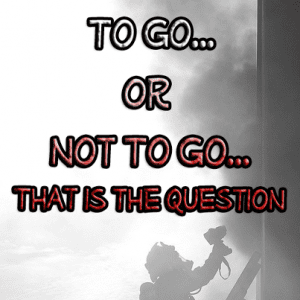 There is an ongoing debate in the fire service. Unless you are unplugged from social media and online journals, you’re surely aware of it. On one end of the argument are those who believe the fire service is tactically too aggressive and purport this may be contributing to casualties.
There is an ongoing debate in the fire service. Unless you are unplugged from social media and online journals, you’re surely aware of it. On one end of the argument are those who believe the fire service is tactically too aggressive and purport this may be contributing to casualties.
On the other side of the argument are those who believe the fire service exists to be aggressive and take a no-bars-held all-out, go-for-broke approach to save lives and property.
I am not going to take sides. I think there is a place and time for aggressiveness and there is a place and time to be conservative. The problem that I see is we are not giving each their due.
Decisions… Decisions
A decision is a choice made among alternatives. Where there is no alternative action that can be taken, no decision needs to be made. So let’s apply this to firefighter training. Every training program focuses on the physical actions needed to perform a rescue or attack a fire.
Sadly, however, some programs fall short by not teaching firefighters how to make critical decisions (such as go or no-go). In such training sessions, the decision is ALWAYS go… and that decision is almost always made by the instructor, yelling at the firefighters to “GO! GO! GO! GO! GO! GO!”
 Hands-on training is essential to build the skills of a firefighter. However, firefighters also need to be taught how to make their own decisions and how to distinguish the difference between go and no-go conditions. Not every fire is a “go” (interior) fire. As firefighters, we so much want them to be. We train as if they will be. But simply, that is not reality.
Hands-on training is essential to build the skills of a firefighter. However, firefighters also need to be taught how to make their own decisions and how to distinguish the difference between go and no-go conditions. Not every fire is a “go” (interior) fire. As firefighters, we so much want them to be. We train as if they will be. But simply, that is not reality.
To even suggest that some firefighters consider the alternative of no-go will surely earn me criticism. I recently read on a social media post where a well-respected fire commander with decades of experience was referring readers to an article he had written that suggested there might be times when conditions warrant a no-go decision.
In the comments below his post was written: “When I read this article, I had to swallow my own vomit.” The profile of the person making the comment revealed he was… ready for it… 19 years old. Where does this kind of bravado come from? I’d say his training had something to do with it.
Teaching conservative actions as an option
I’m not suggesting that firefighters always stand on the outside and spray their water in the windows. I don’t think ANY instructor is advocating for that. What I am saying is that, when conditions are not right for entry, we need to learn how to make those decisions. Making entry when conditions are not right and getting burned or killed doesn’t make anything better, right? Making entry in an effort to save an unsavable life and then, in the process, becoming the victim yourself doesn’t make anything better, right?
 We would be making leaps and bounds progress if we could just get firefighters to realize, and acknowledge, that not every fire presents the conditions that support interior operations. Sometimes this can change with a quick exterior knock-down that takes the energy out of the fire. Sometimes the need to fight the fire from the exterior cannot be changed (i.e., there is not way to reverse the damage to a fire-weakened structure).
We would be making leaps and bounds progress if we could just get firefighters to realize, and acknowledge, that not every fire presents the conditions that support interior operations. Sometimes this can change with a quick exterior knock-down that takes the energy out of the fire. Sometimes the need to fight the fire from the exterior cannot be changed (i.e., there is not way to reverse the damage to a fire-weakened structure).
What kills firefighters?
At a residential dwelling fire, two of the leading ways a firefighter can die while in the act of firefighting is flashover (or being overrun by the fire) and building collapse. These conditions, and the precursors to these conditions, are often visually observable. But, they are only observable for the person who has been trained to look for them and the person who factors this information into their go or no-go decision making process.
The firefighter who has not been taught to consider fire conditions and building decomposition prior to entry will likely make entry… every time… just like he or she has been trained to do.
 From the horses mouths
From the horses mouths
On the SAMatters Radio show (available on iTunes, Stitcher Radio and right here on the SAMatters.com website) I am interviewing firefighters who have survived near-miss events. These people are NOT my hand chosen messengers. They contact me… and volunteer to be interviewed.
In most cases I don’t even know them. But their stories are compelling and it amazes me how many of them have found themselves in compromising situations that nearly cost them their lives. When I press them for answers, they admit they should not have been there. But this revelation comes after the fact, not before.
Training should include options
When training, firefighters should be taught:
• What to do.
• When to do it.
• Where to do it.
• How to do it, and
• Why they are doing it.
Likewise, we would build smarter, thinking firefighters, capable of making better decisions if our training included:
• What NOT to do.
• When NOT to do it.
• Where NOT to do it.
• How NOT to do it, and,
• Why NOT to do it.
Granted, it is far less exciting to teach someone what, when, where, how and why NOT to take the aggressive action… and the accompanying lesson of what the conservative action is.
Chief Gasaway’s Advice
 I am a strong proponent of taking appropriate actions to keep firefighters safe. But I am not a safety zealot. I believe in aggressive actions to save lives and to give those endangered every opportunity to be saved. But, it is simply a fact that we cannot save everyone. I wish we could. It would have reduced the heartache I’ve experienced throughout my career.
I am a strong proponent of taking appropriate actions to keep firefighters safe. But I am not a safety zealot. I believe in aggressive actions to save lives and to give those endangered every opportunity to be saved. But, it is simply a fact that we cannot save everyone. I wish we could. It would have reduced the heartache I’ve experienced throughout my career.
Another recent social media thread I was engaged in was a discussion about aggressive tactics where I made the following statement:
“Expect that you can’t save everyone. God’s plan sometimes is determined prior to our arrival. Thinking firefighters are able to determine when the window of opportunity is still open and when it has closed.”
This comment speaks to the reason for the article you are reading now… teaching firefighters how to think their way through situations. Never try to bully a fire that’s bigger than your resources.
Here is a sampling of the responses I received:
“If we implant that thought process in young firefighters going out the door they are ready to lose on arrival.”
My perspective: If a firefighter going out the door knows that it is not realistic to save all property and save every life, they have a grounded sense of reality and they will be less likely to rush into situations that will prove deadly to the firefighter.
Another respondent stated:
“Thankfully our military does not go into battle with the “you can’t win every battle” attitude.”
My perspective: Military commanders take calculated risks and don’t sent soldiers rushing into situations where the commanders know they are out numbered or out powered. The decisions of military commanders are strategic and calculated (yes, there are well-documented exceptions).
And other said:
“A good plan violently executed now is better than a perfect plan executed next week.”
My perspective: True… just make sure it’s a good plan… not a foolish plan.
I avoid emotional debates on social media for one basic reason: A mind convinced against its will is of the same opinion still. When someone holds strong emotional beliefs, their mind is set and there is little that anyone will do or say to unlock their perspective.
The closest I’ve seen to this “unlocking” of the mind came from my discussion with a very aggressive minded firefighter that I knew. He had a friend die in a structural fire. The facts revealed the structure was quickly on its way to being a total loss and any lives would not have been savable (even though there was no one inside the structure).
He lost a friend and had to witness, first hand, the devastating impact on the widow and small children left behind. As he told me: “All that’s left to show for his efforts is a fenced-in empty lot with knee high weeds and ‘keep out’ signs.” This firefighter’s perspective is quite different now. But what a price paid to change one mind.
If you take the term situational awareness and invert the meaning, it would read: Having an awareness of our situation. While SA is so much more than that simple definition, in this case, it may represent the simplest rendition of what I am trying to say. Be aware of your situation. Then think. Then make smart decisions.
 Action Items
Action Items
1. Discuss how (if) you were taught to make no-go decisions at fires.
2. Discuss the criteria that would warrant a no-go decision.
3. Discuss the potential consequence of aggressive action that should have been conservative action (This includes the potential consequence on your family).
4. Write a note to say goodbye to your family. Sign it but don’t date it. Put it in your locker where it will be found if you are killed in the line of duty.
_____________________________________________________
If you are interested in taking your understanding of situational awareness and high-risk decision making to a higher level, check out the Situational Awareness Matters Online Academy.
CLICK HERE for details, enrollment options and pricing.
__________________________________
Share your comments on this article in the “Leave a Reply” box below. If you want to send me incident pictures, videos or have an idea you’d like me to research and write about, contact me. I really enjoy getting feedback and supportive messages from fellow first responders. It gives me the energy to work harder for you.
Thanks,

Email: Support@RichGasaway.com
Phone: 612-548-4424
Facebook Fan Page: www.facebook.com/SAMatters
Twitter: @SAMatters
LinkedIn: Rich Gasaway
YouTube: SAMattersTV
iTunes: SAMatters Radio


Preach it brother, we truly think alike. I attended one of your classes last year in Gatlinburg Tn. Great knowledge. GOD BLESS
Brad,
Thank you for the support of my mission and for attending my class last year in Gatlinburg. The Tennessee Fire Chiefs was an awesome group to present to.
Rich
Thank you Chief Gasaway. I appreciate your insight on making good decisions. I have watched recruits train for years, and it is always taught to be aggressive. Get to the seat of that fire as quickly as possible. Engrained! I have yet to see a class where they are given pictures of houses on fire and prompted on what they would do. So our challenge is maybe give them the opportunity to see the houses on fire before we start the hands on training. Just a thought